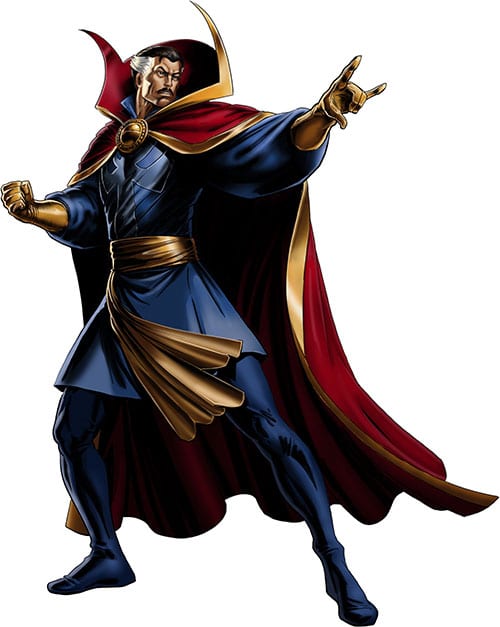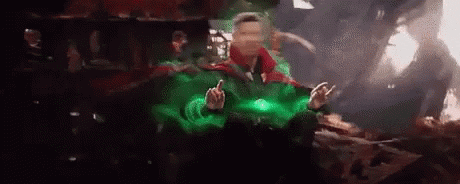It’s time for another installment of the Staying in Character series where we mix, match, and mash our beloved pop culture icons into our favorite tabletop role-playing game systems. It’s never perfect, but we’re always going to put our best foot forward when creating these characters.
Doctor Strange in the Multiverse of Madness is way too far away. It’s outrageous! How can we get our fix of the Sorcerer Supreme? How about a build for Doctor Strange in Pathfinder Second Edition?
With tons of tricks at his disposal, Doctor Strange is practically begging to be built as a high-level magic-user. There are approximately 14 million ways to build Doctor Strange in Pathfinder 2E, and this is just one of them.
Onto the Doctor Strange build!
![]() Step 1: Create a Character Concept
Step 1: Create a Character Concept
Although you can draw your Doctor Strange inspiration from various comic installments, we also benefit from having a standalone Doctor Strange film. I’d also recommend tapping into the character by watching Avengers: Infinity War and Endgame.
Here are the big three points of emphasis for the character that we want to convey in our build:
- Sorcerer Supreme: Doctor Stephen Strange is one of the most powerful beings in the universe. This has to be front-and-center.
- Global Defender: Constantly protecting others from mystic and cosmic threats, Doctor Strange puts others first.
- Clutch Gene: If there’s ever someone you need to show up in a pinch, Doctor Strange is the man. Just when you think his bag of tricks is empty, he taps into his resourcefulness and conjures up the perfect spell for the situation.
![]() Step 2: Start Building Ability Scores
Step 2: Start Building Ability Scores

Paizo likes to ease us into the character-building process. During this step, the main point is to mark off a starting value of 10 for each of your ability scores.
We want to have an idea of how we’re going to spend the Ability Points; what characteristics do we want to showcase? As a magician, Intelligence is definitely high on our list of priorities. You can also make an argument for Wisdom, considering Doctor Strange’s experiences through foresight.
We also know that Doctor Strange went through rigorous training with monks. In fact, Wong ensures that Strange’s martial abilities are always improving. Therefore, Dexterity isn’t something that we want to completely ignore.
And how about that mustache? That’s Charisma-incarnate.
![]() Step 3: Select an Ancestry
Step 3: Select an Ancestry
Doctor Strange is definitely a Human, but let’s bend the rules a little bit with this build. After all, it’s fun to play something other than a Human; we do that every day!
The Elves of Golarian have been around a long time. They’ve seen the world change for better and worse, but are adaptive enough to still be in the picture.
Doctor Strange, through his prophetic abilities, knows how actions fit into the grander scheme of the world’s history. He may be a human on the page and screen, but in this game he certainly seems to fit the description of an Elf.
Elves get boosts to Intelligence and Dexterity, which happens to work rather nicely for our character. This is especially true if we want to add any monk-abilities at later levels.
To continue along the mystic path, let’s also give Doctor Strange the Seer Elf Ancestry Heritage. Not only does this ability give bonuses to Decipher Writing, but we also get Detect Magic as a cantrip.
For his Ancestry Feat, I’m torn between Forlorn and Otherwordly Magic. Both are great choices. Forlorn works well from a character perspective, highlighting Doctor Strange’s Global Defender trait.
In the end, I’m going with Otherworldly Magic. After all, a master magician should be able to cast multiple spells at-will. Doctor Strange is getting Shield as a Cantrip!

![]() Step 4: Pick a Background
Step 4: Pick a Background
Backgrounds give us some insight and direction into how a character developed over time. Doctor Strange is a master of the occult, and also deals with prophecy quite a bit.
While perusing the list of Pathfinder Second Edition Backgrounds, one immediately catches my eye: Fortune Teller. This give us an Intelligence or Charisma boost. It also grants Doctor Strange the Occultism skill.
It’s only mildly alluded to in the Marvel films, but Doctor Strange has a keen eye for mystical artifacts. The Fortune Teller background grants an ability called Oddity Identification. Basically, we’re getting bonuses to identify strange artifacts, which is right up our alley.
![]() Step 5: Choose a Class
Step 5: Choose a Class
This one is tough. On paper, Doctor Strange is a Sorcerer! The Sorcerer Supreme, in fact.
At the same time, it was his dedication and discipline that allowed Doctor Strange to gain his magical abilities. If it wasn’t for his intense physical and mental desire to be something more, he wouldn’t have become the powerful being that he is today.
Sounds like a Wizard to me! For the purposes of this build, Wizard is the route I’m taking. At the end of the day, I want to showcase a myriad of spells. The limited access of Sorcerers is what turns me off to that class in this case.
As I mentioned above, taking a Monk Dedication is something to consider down the line. If a Sorcerer can hold their own in melee, that’s a blessing for any party. Remember that you need a Strength and Dexterity of 14 to take a Monk Dedication, so plan ahead if you want that by Level 5.

![]() Step 6: Determine Ability Scores
Step 6: Determine Ability Scores
Most of our Ability Score adjustments are already accounted for, but we still have our 1st Level boosts to make. I’ll recap each skill to show the choices that I made, and the reasoning behind them:
- Strength: 10 = 10 (Base). Doctor Strange isn’t hitting the gym with regularity.
- Dexterity: 14 = 10 (Base) + 2 (1st Level) + 2 (Ancestry). All of that monk training is being put to good use.
- Constitution: 10 = 10 (Base) + 2 (1st Level) – 2 (Ancestry Flaw). He has an average constitution for a hero.
- Intelligence: 18 = 10 (Base) + 2 (1st Level) + 2 (Ancestry) + 2 (Background) + 2 (Class). Boom! Doctor Strange can access magics that are out-of-reach for most.
- Wisdom: 14 = 10 (Base) + 2 (1st Level) + 2 (Ancestry). A breadth of experiences and memories imparts a wealth of wisdom.
- Charisma: 12 = 10 (Base) + 2 (Background). People are always willing to hear what Doctor Strange has to say, even if his bedside manner is somewhat lacking.
![]() Step 7: Record Class Details
Step 7: Record Class Details
Being a spellcaster, we have a lot of choices to make at this juncture. Let’s start with our arcane spells. Wizards get a luxurious 10 cantrips and five 1st Level spells to start out. Here’s what I chose:
- Acid Splash
- Dancing Lights
- Daze
- Electric Arc
- Floating Disk
- Grim Tendrils
- Mage Armor
- Mage Hand
- Magic Missile
- Message
- Prestidigitation
- Produce Flame
- Read Aura
- Sleep
- Telekinetic Projectile
There is a ton of utility in this list. Remember how we wanted to show how Doctor Strange is resourceful in sticky situations? We have something for whatever crazy shenanigans the GM can throw at us.
For our Arcane Bond, let’s hope that our Gamemaster is kind enough to let us have a necklace version of the Eye of Agamotto. The rules allow for a ring or similar item, so we can always reskin that as needed.
Our Arcane Thesis is Spell Substitution. Again, this taps into Doctor Strange’s utility, allowing us to use whatever spell is needed for the situation at hand. It takes 10 minutes, but in Pathfinder Second Edition that’s a frequent occurrence.
Divination is the ideal Arcane School for a Fortune Teller. If you don’t want to lean as heavily into the divining nature of Doctor Strange, then I’d go with Universalist. That being said, I’m choosing True Strike as my free 1st Level Divination spell.
Now it’s time for the Skills. Based on what we’ve already selected, Doctor Strange already has Arcana, Fortune-Telling Lore, and Occultism. That means we get six more selections, so let’s see what I went with:
- Athletics: Training with the monks helped to build Doctor Strange’s core.
- Nature: Geography and topography will aid the party in navigating the wilds.
- Crafting: When you have access to high-level magic, it isn’t outlandish that you’d be able to craft some awesome items.
- Society: Understanding the intricacies of a given Society is important in understanding political motives and hidden agendas.
- Diplomacy: Doctor Strange is here to bargain.
- Intimidation: When Diplomacy fails, demonstrating raw magical power can be enough to change even the most stubborn of minds.

![]() Step 8: Buy Equipment
Step 8: Buy Equipment
Starting out, we have 150 sp to spend as we desire. Doctor Strange, like most wizards, is going to be spending money on runes and enchanted items down the road. Right now, we just need to pick up the basics.
If you want, go ahead and buy a crossbow for ranged attacks. It’s expensive (30 sp) so it’s not the right move for everyone. A Hand Crossbow works well too, only requiring one hand to shoot.
I’m also going to get a dagger and sheath, which is a paltry 2 sp and 1 cp together. And what’s a wizard without the capacity to carry scrolls? Let’s pick up a scroll case for 1 sp.
Wizards don’t need armor, especially with Mage Armor and Shield. If you want to apply runes later, however, you should probably put on a set of clothes. Explorer’s Clothing is a free pickup that will work out nicely.
It’s usually a safe bet to pick up a class kit, so I’ve done that for Doctor Strange. At 12 sp, it’s not terribly expensive, and it comes with all the odds and ends that a good adventurer needs.
At this point, we still have some gold to our name, so spend that as you see fit. Otherwise, put it in the rainy-day fund for some future equipment upgrades.

![]() Step 9: Calculate Modifiers
Step 9: Calculate Modifiers
Work through the calculations for your Perception, Saving Throws, Strikes, and Skills. I’ve provided a character sheet for this build below, which has everything calculated for you. If you’ve made any changes, however, you’ll be on your own for doing the math.
![]() Step 10: Finishing Details
Step 10: Finishing Details
All we need to do is tidy up some minute character details. After that, Doctor Strange is ready to be thrown out into the wild! Be sure to fill in these details on the appropriate sections of your character sheet.
- Alignment: Lawful Neutral. Doctor Strange follows a simple code: protect the world. He’s not going against this ethos, and everything he does stems from this singular desire.
- Deity: Nethys is the perfect deity for Strange. Nethys’ background is that his ability to witness all things has ‘shattered his mind’. He is also known as the All-Seeing Eye. How perfect!
Those are the big two decisions to make in this section. The Class DC, Armor Class (AC), and Bulk values are all determined by previous choices. Check the Core Rulebook (pg 29) for additional information in calculating these.
![]() Step 11: Beyond 1st Level
Step 11: Beyond 1st Level
If we look ahead to 5th Level, Doctor Strange is going to be a powerhouse. Although we’re not quite ready to dip into a Monk Dedication (since we lack the Strength), we can still lay some more groundwork to make that a reality.
For Abilities, we’ll increase Strength, Dexterity, Constitution, and Intelligence. This sets us up for Monk in the future, but also rounds out the character a bit more.
Arcana and Occultism are getting bumped up to Expert-level Skills. These will be used often, and magic is Doctor Strange’s strong suit.
Now for the Feats. Steady Spellcasting is a must. Doctor Strange doesn’t let anything get in the way of his concentration. His mind is a steel trap!
I also want to take Familiar, and essentially animate his cloak to mimic the Cloak of Levitation. Obviously it’s not going to have the awesome abilities, and the GM has to approve it, but it would be SO MUCH FUN. Just for the record, I would allow it at my table.
For the other Feats, I’m choosing Group Impression, Recognize Spell, and Magical Shorthand. Not only will this help make Doctor Strange the ‘face’ of the party, but it enhances his magical knowledge. They’re not flashy Feats, but they’re utilitarian; they’re exactly what we want. Ageless Patience is a good Ancestry Feat that plays well with Doctor Strange’s uncanny concentration.
Don’t forget to pick up your new spells, either! Two extra spells per level will give you lots of room to customize your character. Here are the choices I made:
- Unseen Servant
- Feather Fall
- Dispel Magic
- Flaming Sphere
- Invisibility
- Telekinetic Maneuver
- Hypnotic Pattern
- Clairaudience
As far as equipment, here are some items that might be worth looking into. A Mentalist’s Staff is a solid 4th-level item to grant a few extra spells. Since you’re going to be out of melee range for a good chunk of the time, Bracers of Missile Deflection could be handy. I’m also springing for a Hat of the Magi to help with Arcana checks.

Doctor Strange Meets Pathfinder 2E
I’ve attached a Hero Lab Online Character Sheet that outlines the choices we made in this build. This should give you a decent starting point to building this character, or else free to use it as-is!
There are two total files below, representing the Level 1 and Level 5 versions of this character. Each Level has a character sheet, an abilities/gear description sheet, and spell descriptions. It’s a one-stop shop!
Doctor Strange Character Sheet Files
This series will feature builds in Starfinder, Pathfinder, and D&D 5E. Keep your eyes peeled for future installments. Reach out to us on Twitter if there’s something you really want to see.
Until then, in the words of Doctor Strange, “Study and Practice. Years of it.”

